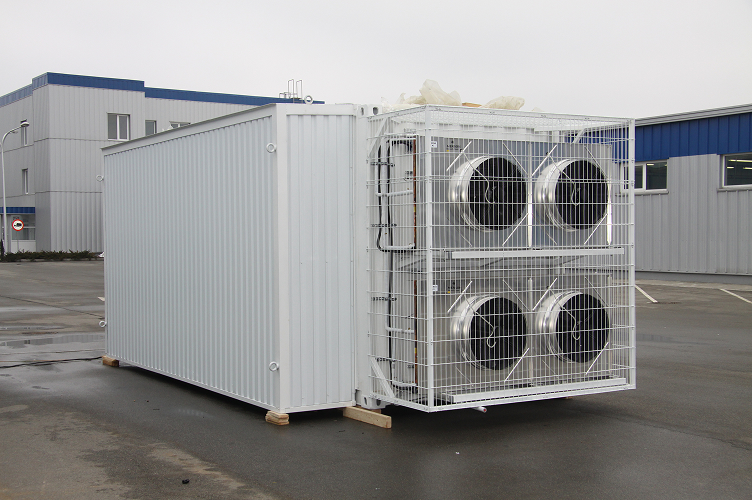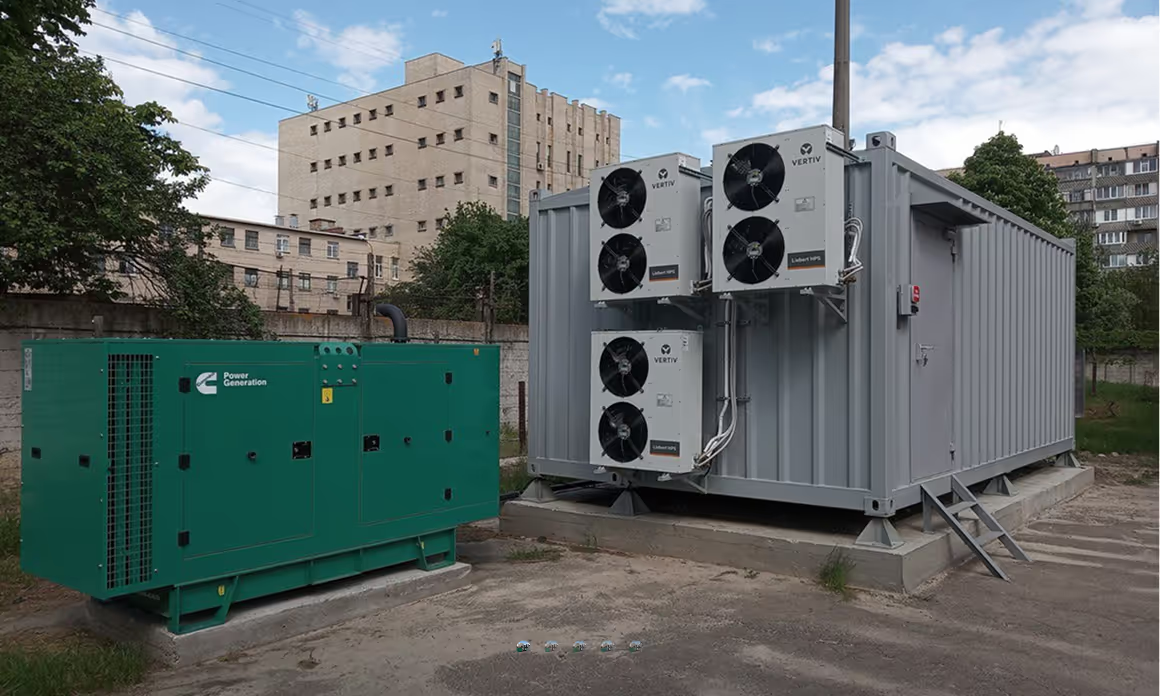Ukraine
Modular Data Centers for National Road-Traffic Video Capture Infrastructure
Two-site, four-module complex providing 320 kW total IT load, N+1 power and cooling, and full data replication for nationwide traffic-violation analytics.
Book a 30-min call

Context
Ukraine’s national program for road-violation video capture required geographically redundant infrastructure to ingest, process, and securely store video evidence. The platform demanded low latency, local data retention, and continuous availability despite possible power or network disruptions. Conventional fixed builds would have taken years; the customer instead adopted a modular approach for speed and lifecycle flexibility.
At a glance

Customer
National security / public safety organization (anonymized)

Use case
Stand‑by edge compute that can relocate within ~1 hour from disconnect to roll‑out

Outcome
All‑in‑one ISO‑container MDC mounted on wheeled platforms; high availability designed to meet Tier III principles; quick‑disconnect power and low‑voltage (LV) signaling

Transport & siting
Standard 40‑ft High Cube ISO form factor; road‑legal width; platform leveling via screw jacks

Time‑to‑deploy
Within hours (pre‑staged playbook)

IT capacity
Up to 40 kW across six 42U racks
Challenges
— Mobility hardware
Wheeled platforms with rated jacking points; exterior quick‑connect panels for power and LV; protection for connectors during transit
— Power
Modular UPS (power + battery modules in one frame) providing ~10 minutes autonomy at design load; 2N power distribution; generator‑ready
— Cooling
Row‑based precision air‑conditioning with humidity control; uninterruptible air‑conditioning; N+1 on main HVAC components
— Fire & safety
Automatic clean‑agent suppression; early warning detection
— Security & monitoring
Access control, CCTV, infrastructure & environmental telemetry with alarms
Solution
A dual-site, four-module modular data-center complex was deployed to host and replicate the national video-capture data. Each site includes two 40-ft IT modules operating as a single fault-tolerant unit.
Power, cooling, and networking subsystems were engineered for parallel operation and independent maintenance.

Key features
— Reliability
Support uninterrupted 24/7 video ingestion and analytics across hundreds of roadside nodes
— Continuity
Survive utility outages and maintain compute uptime through redundancy
— Deployment speed
Achieve national rollout within months under tight regulatory scrutiny
— Connectivity
Handle large streaming data flows with structured fiber cabling and clean cable management
— Compliance
Ensure shielding and resilience standards for public-safety systems
Custom engineering

Two-site topology
Full data replication between sites; any single site failure keeps national system online

Redundant power chain
Dual feed + generator + ATS for each module, ensuring automatic switchover

Cabling density
IANOS solution optimized for compact modular enclosures and fast field replacement

Shielding integration
EM protection applied during fabrication to meet national communication-security requirements

Regulatory path
Local production simplified approvals and shortened build-to-operation timeline to ~4 months
Results

Operational resilience
Dual-site, four-module setup ensures data capture continuity during maintenance or outages

Energy efficiency
In-row cooling balanced thermal load across racks, maintaining performance at 15 kW/rack

On-time rollout
From concept to service in ≈ 4 months — faster than any conventional facility

Network readiness
Structured cabling future-proofed for 40/100 Gb/s links
Specs snapshot
Sites / modules
2 sites ×
2 modules (4 total)
Per-module IT load
6 80 kW
Per-rack: up to 15 kW
Power resilience
Dual feeds + 160 kW Cummins DCC
genset + ASCO 230 ATS per module
Cooling
In-row air conditioning
UPS
Modular redundant design
Cabling
HUBER+SUHNER IANOS
(72 LC Duplex / 1U, 10 → 40/100 Gb/s)
Build & compliance
Local manufacture with EM shielding;
commissioned in ≈ 4 months
Business value and fit

Value
Rapid, compliant, and resilient compute backbone for national video-analytics systems; reusable modular asset that scales by adding modules

Ideal for
Public safety, transport agencies, and smart-city video analytics deployments

Options
EMP/EMI shielding, enhanced dust and temperature packages, extended bandwidth fabrics for future sensor loads

Not ideal for
Hyperscale or AI-training clusters (>120–150 kW/rack)
FAQ
What is a modular data center?
A modular data center (MDC) is a prefabricated, container-based data center that integrates racks, power, cooling, and security systems inside portable enclosures. Unlike traditional on-site construction, a containerized modular data center is factory-built, tested, and shipped ready for installation. ModulEdge designs scalable modular data centers from 5–50 kW per rack with DX, chilled-water, adiabatic, and free-cooling options — engineered for edge and AI workloads where reliability and low latency matter most.
Why consider a modular data center?
A container modular data center enables faster deployment, lower risk, and predictable performance compared to conventional builds. Prefabricated and tested in the factory, these systems minimize site work and allow operators to scale step-by-step as demand grows. Organizations in telecom, industry, energy, and defense choose mobile and containerized data centers to place compute closer to operations, improve resilience, and maintain on-prem control of sensitive workloads. ModulEdge’s portable modular data center solutions combine EU engineering with ruggedized designs for harsh conditions.
How are modular data centers different from traditional data centers?
Traditional data centers are built on-site, requiring long construction cycles and multiple contractors. A prefabricated modular data center is built in controlled factory conditions, integrating power, cooling, fire suppression, and monitoring systems before shipment. This approach cuts deployment from years to months, ensures quality through FAT/SAT testing, and allows redeployment when operations move. ModulEdge’s containerized data center infrastructure offers the same Tier III/IV design principles as conventional facilities — with faster rollout, lower cost, and modular scalability.
Are you Tier III certified?
Our modules are designed to meet Tier I - IV principles. Certification applies to a specific site and build; we support auditor engagement for deployments that pursue certification.
Do you support AI training clusters?
No. We position for edge AI inference at ≥40 kW per rack. Training‑class densities (≈120–150 kW/rack) are not feasible in this form factor.
What’s the typical lead time?
Custom builds: 3–6 months. Commissioning depends on scope and site readiness (power, pad, network). We’ll confirm a schedule during design review.
How do you handle hot or variable climates?
We match DX, chilled‑water, adiabatic, or free‑cooling to your climate and energy costs, targeting predictable efficiency (modeled PUE) and thermal headroom.
Can the modules handle harsh environments?
Yes – dust/sand/humidity hardening, vibration tolerance, and optional EMP shielding are available to maintain uptime in demanding sites.
Will this integrate with our existing monitoring and access control?
Yes. We deliver integrated monitoring and access/CCTV and align interfaces during design review to fit your tooling and security policies.
Can we redeploy modules later?
Yes. Standard 20‑ft and 40‑ft footprints with a redeployable approach; we provide rigging/placement plans and support relocation.
Do you sell direct or via partners?
We’re partner‑first (OEM/whitelabel and system integrators). End‑user projects are delivered with or through partners.